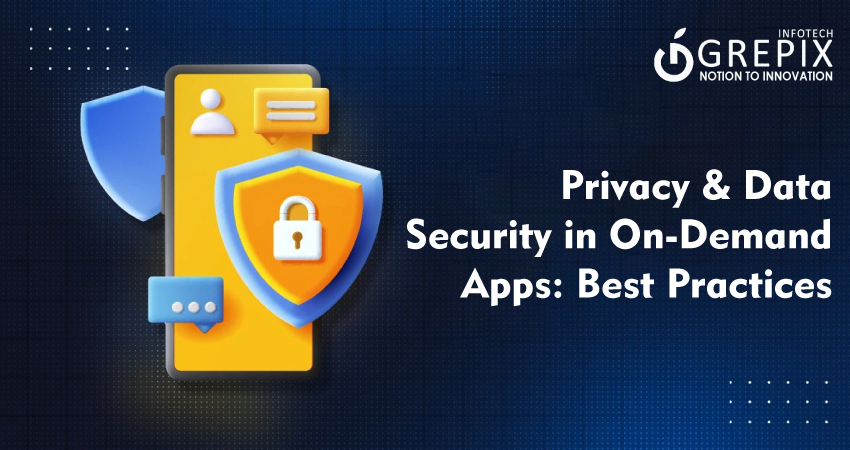Privacy & Data Security in On-Demand Apps: Best Practices
Every on-demand app collects sensitive user data names, addresses, payment details, location coordinates and transmits it through the cloud. Without robust privacy on-demand apps strategies, these details become prime targets for cybercrime.
According to Statista, mobile app data breaches rose by over 30% in 2024. In the dynamic on-demand ecosystem, where one compromised transaction can ruin trust, app developers must treat privacy as integral to brand reputation.
Privacy and data security apps are not optional investments; they are the foundation of user loyalty. A secure payment ride-hailing or food delivery experience directly influences repeat usage and long-term retention. Developers who prioritize protection through encryption, two-factor authentication, and GDPR compliance app development set themselves apart in an increasingly competitive sector.
In an era where every click, location, and purchase generates data, the reliability of on-demand apps depends on the strength of their privacy and security standards. With mobile transactions rising and digital ecosystems expanding, users expect every app they use whether for ride-hailing, food delivery, or home services to prioritize personal information protection. This blog reveals proven strategies for developing privacy on-demand apps that prioritize security and compliance. From encrypted transactions in secure payment ride-hailing platforms to GDPR compliance app development frameworks, you’ll learn how trust, encryption, and transparency can fuel business growth. We also cover real-world breaches, preventative approaches, and methods successful apps use to guard sensitive data. For developers, entrepreneurs, and app owners alike, this detailed guide provides a clear path to embracing cybersecurity as a competitive strength rather than a regulatory checkbox.
1Data Privacy Challenges in On-Demand Apps
The High Stakes of Personal Data
On-demand platforms depend on real-time access to user data pickup locations, saved cards, and delivery addresses. But the more data an app processes, the greater the risk if security fails. Privacy on-demand apps face these major challenges:
- Data Leakage through APIs: Poorly secured APIs can leak sensitive user data between services.
- Man-in-the-Middle (MITM) Attacks: Intercepting data transfers between client and server remains one of the most common breaches.
- Third-Party Vulnerabilities: Many data security apps rely on external services (e.g., maps or analytics), which can introduce weak links.
- Weak Authentication: Reused passwords or lack of biometric validation make accounts easy to exploit.
In 2023, a major ride-hailing app suffered a breach exposing 57 million users’ records. It happened due to unpatched cloud storage an easily preventable mistake. This reinforces that privacy on-demand apps require consistent updates, audits, and patching cycles.
Why On-Demand Platforms are Prime Targets
Cybercriminals focus on these platforms because:
- They store payment information and personal identifiers.
- Many operate under high load, reducing developers’ ability to monitor requests for anomalies.
- Users often use unsecured networks (like public Wi-Fi), increasing interception risk.
The takeaway: On-demand platforms must combine preventive and responsive security layers, adopting both technical and human-centric approaches.
2Encryption and Secure Payment Protocols
Strong encryption is the cornerstone of data security apps. It ensures that even if data is intercepted, it cannot be read or exploited.
Common Encryption Models in Privacy On-Demand Apps
- AES (Advanced Encryption Standard): The industry standard for encrypting sensitive data.
- RSA Encryption: Used for securing communications and verifying identities.
- TLS (Transport Layer Security): Protects data in transit during API and web communications.
- A practical example: In secure payment ride-hailing apps like Uber or Bolt, sensitive details such as card information are tokenized meaning replaced by encrypted tokens that transmit without revealing the actual number.
Secure Payment Frameworks
With over 2.8 billion people using mobile wallets globally in 2025, ensuring secure payments is non-negotiable. Developers should:
- Store minimal payment details locally.
- Use payment gateways with built-in anti-fraud detection.
- Implement SSL certificates and HSTS security headers.
- Use multi-layered verification (e.g., CVV and biometric authentication).
Leading payment processors like Stripe and Razorpay follow PCI-DSS standards, ensuring that every secure payment ride-hailing or delivery transaction adheres to global safety benchmarks.
End-to-End Encryption (E2EE)
Beyond transactions, messages and user communications (like delivery chats or support requests) also need encryption. End-to-end encrypting ensures conversations remain private between sender and receiver, a standard now embraced by leading data security apps.
3Compliance and Regulatory Standards: GDPR, CCPA, and Beyond
A strong privacy foundation is impossible without regulatory compliance. GDPR compliance app development has become a gold standard for respecting user rights.
Overview of Global Frameworks
- GDPR (Europe): Grants users the right to access, delete, and control how data is processed.
- CCPA (California): Focuses on giving consumers transparency into data usage.
- PDPA (Singapore) & LGPD (Brazil): Regional frameworks promoting consent-based data sharing.
Key GDPR Compliance Practices for On-Demand Apps
- Explicit Consent: Collect user consent before processing data.
- Data Minimization: Only gather information essential for the app’s functions.
- Right to Be Forgotten: Allow users to delete their data upon request.
- Breach Notification: Report a breach within 72 hours.
- Data Protection Officers (DPO): Assign dedicated roles for oversight.
Implementing GDPR compliance app development doesn’t just prevent penalties but builds user trust. Users today read privacy policies and demand transparency before granting permissions.
Apps like Airbnb and Deliveroo show this clearly. They provide dashboards for users to manage stored information, delete accounts, and review permissions anytime.
4Building User Trust Through Transparency and Communication
Privacy practices only matter if users can see and understand them. Data security apps must integrate transparency at every step from onboarding to updates.
Communicating Security Measures
- Clear Privacy Policies: Use plain language, not legal jargon.
- Consent Requests in Context: Explain why permissions (e.g., for location or contacts) are needed.
- Trust Badges and Certifications: Display compliance logos or PCI badges in checkout pages.
Transparent communication enhances reputation. A 2024 IBM survey reported that 78% of users are more likely to remain loyal to brands that clearly explain data handling practices.
Empowering Users with Control
Allow users to:
- Manage or revoke app permissions easily.
- Disable location tracking post-ride or delivery.
- Adjust personalized advertising preferences.
- Report suspicious in-app activity promptly.
This empowerment drives retention and advocacy. When people trust privacy on-demand apps, they stay longer and spend more.
Also Read: Accelerating Your Fortune: Becoming a Billionaire in South Africa's Taxi Industry
5Case Studies: Secure On-Demand Platforms in Action
Uber: Layered Encryption and Privacy Controls
Uber protects personal data through multi-layer encryption and advanced tokenization. It also introduced a Safety Toolkit enabling users to manage location-sharing and emergency assistance easily. These advances confirmed Uber’s commitment as a benchmark in secure payment ride-hailing.
DoorDash: Regulatory Compliance and Breach Recovery
After suffering a breach in 2019, DoorDash invested heavily in security frameworks, adding continuous monitoring and staff security training. Its revamped system aligns with GDPR compliance app development principles, significantly reducing vulnerabilities.
Zomato: Transparency and Tokenization for Food Delivery
Zomato uses AES-256 encryption, PCI-DSS compliance, and anonymous data analytics. Customers can now delete personal history crucial for meeting privacy on-demand apps regulations.
These examples prove that proactive privacy and robust encryption attract positive press and loyal customers worldwide.
6Best Practices for Developing Privacy-Focused On-Demand Apps
To build strong data security apps, developers and business owners must embed security right from ideation.
Adopt Privacy by Design
Incorporate security considerations into product architecture. Conduct data flow mapping to recognize collection points and implement encryption early.
Use Secure APIs and SDKs
Third-party integrations power efficient development but can be attack vectors. Always verify the security certification of SDKs, and rotate API keys frequently.
Run Regular Penetration Testing
Simulate breaches before criminals do. Third-party testers can identify potential vulnerabilities in authentication flows and data storage methods.
Limit Data Storage and Set Expiry Policies
The longer data remains in storage, the riskier it becomes. Set expiry policies for temporary data like session tokens and cached addresses.
Implement 2FA and Biometric Verification
Secure payment ride-hailing platforms increasingly add fingerprint or face ID logins. This not only protects data but also enhances convenience.
Continuous Monitoring and Incident Response
Detect anomalies early through intrusion detection systems (IDS). In parallel, implement documented breach-response workflows to mitigate leaked data immediately.
When combined, these practices ensure privacy on-demand apps meet high global standards while staying adaptable to evolving threats.
7Emerging Technologies Strengthening Data Security
Blockchain-Based Data Protection
Blockchain decentralizes storage, reducing single points of failure. Future data security apps may lean on blockchain to record user consent and process transactions traceably.
AI-Driven Threat Detection
Artificial intelligence enables real-time anomaly detection, identifying unauthorized access or geolocation mismatches. Companies like Cloudflare now integrate AI for continuous protection.
Edge Computing
Processing data closer to the user (on the device itself) minimizes exposure and latency. This is particularly useful for ride-hailing apps that rely on GPS data.
The combination of these technologies shapes the next generation of GDPR compliance app development processes that ensure privacy without sacrificing performance.
Conclusion
Strong data protection is now a core part of customer experience not a technical afterthought. Users expect privacy, transparency, and respect for their data rights in every app they use. For developers and businesses, this means integrating security into product DNA and maintaining it through continuous testing and compliance updates.
Privacy on-demand apps that adopt encryption, secure payment ride-hailing frameworks, and strict GDPR compliance practices not only prevent breaches but also stand out in crowded app markets. By investing in these solutions early, businesses turn privacy into a decisive trust signal.
FAQs
1. Why is data privacy crucial in on-demand apps?
User trust depends on how securely personal data is collected, stored, and shared. Breaches can severely damage reputation and retention.
2. What technologies improve app data security?
Encryption, AI threat detection, and blockchain-powered consent systems are leading innovations.
3. How can developers ensure GDPR compliance?
By embedding privacy-by-design principles, ensuring opt-in consent, and providing easy access to data deletion controls.
4. What are the best practices for secure payments?
Use tokenization, SSL certification, multi-factor authentication, and PCI-DSS compliant payment gateways.
5. How often should security audits be performed?
At least once per quarter or after any major code or feature changes to ensure continued compliance.
Launch your vision with our mobile app development company, where innovation meets excellence to create cutting edge mobile solutions.







